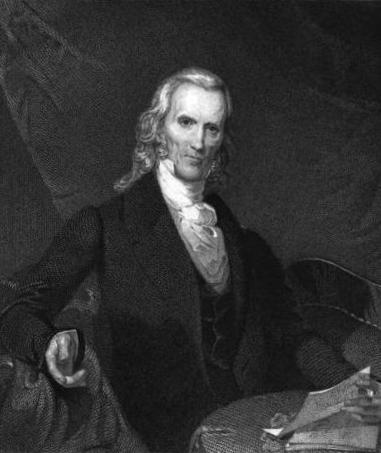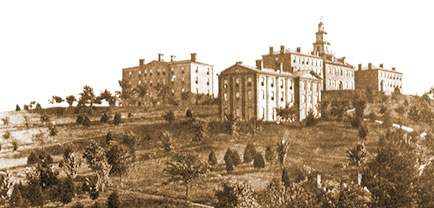|
First Presbyterian Church Cemetery
The First Presbyterian Church Graveyard is the oldest graveyard in Knoxville, Tennessee, United States. Established in the 1790s, the graveyard contains the graves of some of Knoxville's most prominent early residents, including territorial governor and Philadelphia Convention, Constitutional Convention delegate William Blount and Knoxville founder James White (general), James White.Jack Neely, ''The Marble City: A Photographic Tour of Knoxville's Graveyards'' (Knoxville, Tenn.: University of Tennessee Press, 1999), pp. xvi-xix. In 1996, the graveyard was added to the National Register of Historic Places. While platting Knoxville with his son-in-law, Charles McClung, in 1791, White ordered at least one lot to be set aside for a church and cemetery. The cemetery spot may have been used as early as the 1780s for burials, and the cemetery contained several graves by 1799, but the earliest marker is Blount's, dated 1800. While the First Presbyterian congregation was active in the ... [...More Info...] [...Related Items...] OR: [Wikipedia] [Google] [Baidu] |
Knoxville, Tennessee
Knoxville is a city in and the county seat of Knox County, Tennessee, Knox County in the U.S. state of Tennessee. As of the 2020 United States census, Knoxville's population was 190,740, making it the largest city in the East Tennessee Grand Divisions of Tennessee, Grand Division and the state's third largest city after Nashville, Tennessee, Nashville and Memphis, Tennessee, Memphis.U.S. Census Bureau2010 Census Interactive Population Search. Retrieved: December 20, 2011. Knoxville is the principal city of the Knoxville Metropolitan Area, Knoxville Metropolitan Statistical Area, which had an estimated population of 869,046 in 2019. First settled in 1786, Knoxville was the first capital of Tennessee. The city struggled with geographic isolation throughout the early 19th century. The History of rail transportation in the United States#Early period (1826–1860), arrival of the railroad in 1855 led to an economic boom. The city was bitterly Tennessee in the American Civil War#Tenne ... [...More Info...] [...Related Items...] OR: [Wikipedia] [Google] [Baidu] |
Union (American Civil War)
During the American Civil War, the Union, also known as the North, referred to the United States led by President Abraham Lincoln. It was opposed by the secessionist Confederate States of America (CSA), informally called "the Confederacy" or "the South". The Union is named after its declared goal of preserving the United States as a constitutional union. "Union" is used in the U.S. Constitution to refer to the founding formation of the people, and to the states in union. In the context of the Civil War, it has also often been used as a synonym for "the northern states loyal to the United States government;" in this meaning, the Union consisted of 20 free states and five border states. The Union Army was a new formation comprising mostly state units, together with units from the regular U.S. Army. The border states were essential as a supply base for the Union invasion of the Confederacy, and Lincoln realized he could not win the war without control of them, especially Maryla ... [...More Info...] [...Related Items...] OR: [Wikipedia] [Google] [Baidu] |
John Williams (Tennessee Politician)
John Williams (January 29, 1778 – August 10, 1837) was an American lawyer, soldier, and statesman, operating primarily out of Knoxville, Tennessee, in the first part of the 19th century. He represented Tennessee in the United States Senate from 1815 to 1823, when he lost reelection to Andrew Jackson. Williams also served as colonel of the 39th U.S. Infantry Regiment during the Creek Wars, and played a key role in Jackson's victory at the Battle of Horseshoe Bend in 1814. Williams later distanced himself from Jackson, and aligned himself with John Quincy Adams and Henry Clay. Adams appointed him chargé d'affaires to the Central American Federation in 1825. Early life Williams was born in what is now Forsyth County, North Carolina (then part of Surry County), the third of twelve children of Joseph and Rebekah Lanier Williams. His father was of Welsh descent, and his mother was descended from French Huguenots. Two of Williams' brothers, Lewis Williams and Robert Williams, ... [...More Info...] [...Related Items...] OR: [Wikipedia] [Google] [Baidu] |
Daughters Of The American Revolution
The Daughters of the American Revolution (DAR) is a lineage-based membership service organization for women who are directly descended from a person involved in the United States' efforts towards independence. A non-profit group, they promote education and patriotism. The organization's membership is limited to direct lineal descendants of soldiers or others of the Revolutionary period who aided the cause of independence; applicants must have reached 18 years of age and are reviewed at the chapter level for admission. The DAR has over 185,000 current members in the United States and other countries. Its motto is "God, Home, and Country". Founding In 1889 the centennial of President George Washington's inauguration was celebrated, and Americans looked for additional ways to recognize their past. Out of the renewed interest in United States history, numerous patriotic and preservation societies were founded. On July 13, 1890, after the Sons of the American Revolution refused t ... [...More Info...] [...Related Items...] OR: [Wikipedia] [Google] [Baidu] |
Whig Party (United States)
The Whig Party was a political party in the United States during the middle of the 19th century. Alongside the slightly larger Democratic Party, it was one of the two major parties in the United States between the late 1830s and the early 1850s as part of the Second Party System. Four presidents were affiliated with the Whig Party for at least part of their terms. Other prominent members of the Whig Party include Henry Clay, Daniel Webster, Rufus Choate, William Seward, John J. Crittenden, and John Quincy Adams. The Whig base of support was centered among entrepreneurs, professionals, planters, social reformers, devout Protestants, and the emerging urban middle class. It had much less backing from poor farmers and unskilled workers. The party was critical of Manifest Destiny, territorial expansion into Texas and the Southwest, and the Mexican-American War. It disliked strong presidential power as exhibited by Jackson and Polk, and preferred Congressional dominance in lawma ... [...More Info...] [...Related Items...] OR: [Wikipedia] [Google] [Baidu] |
Hugh Lawson White
Hugh Lawson White (October 30, 1773April 10, 1840) was a prominent American politician during the first third of the 19th century. After filling in several posts particularly in Tennessee's judiciary and state legislature since 1801, thereunder as a Tennessee Supreme Court justice, he was chosen to succeed former presidential candidate Andrew Jackson in the United States Senate in 1825. He became a member of the new Democratic Party, supporting Jackson's policies and his future presidential administration. However, he left the Democrats in 1836 and was a Whig candidate in that year's presidential election.Mary Rothrock, ''The French Broad-Holston Country: A History of Knox County, Tennessee'' (Knoxville, Tenn.: East Tennessee Historical Society, 1972), pp. 501-502. An ardent strict constructionist and lifelong states' rights advocate, White was one of President Jackson's most trusted allies in Congress in the late 1820s and early 1830s.Nancy Scott, A Memoir of Hugh Lawson White' ... [...More Info...] [...Related Items...] OR: [Wikipedia] [Google] [Baidu] |
Bijou Theatre (Knoxville)
The Bijou Theatre is a theater located in Knoxville, Tennessee, United States. Built in 1909 as an addition to the Lamar House Hotel, the theater has at various times served as performance venue for traditional theatre, vaudeville, a second-run moviehouse, a commencement stage for the city's African-American high school, and a pornographic movie theater. The Lamar House Hotel, in which the theater was constructed, was originally built in 1817, and modified in the 1850s. The building and theater were added to the National Register of Historic Places in 1975.Dean Novelli, "On a Corner of Gay Street: A History of the Lamar House—Bijou Theater, Knoxville, Tennessee, 1817 – 1985." East Tennessee Historical Society ''Publications'', Vol. 56 (1984), pp. 3-45. The Lamar House Hotel was built by Irish immigrant Thomas Humes (1767–1816) and his descendants, and quickly developed into a gathering place for Knoxville's wealthy. In 1819, Andrew Jackson became th ... [...More Info...] [...Related Items...] OR: [Wikipedia] [Google] [Baidu] |
University Of Tennessee
The University of Tennessee (officially The University of Tennessee, Knoxville; or UT Knoxville; UTK; or UT) is a public land-grant research university in Knoxville, Tennessee. Founded in 1794, two years before Tennessee became the 16th state, it is the flagship campus of the University of Tennessee system, with ten undergraduate colleges and eleven graduate colleges. It hosts more than 30,000 students from all 50 states and more than 100 foreign countries. It is classified among "R1: Doctoral Universities – Very high research activity". UT's ties to nearby Oak Ridge National Laboratory, established under UT President Andrew Holt and continued under the UT–Battelle partnership, allow for considerable research opportunities for faculty and students. Also affiliated with the university are the Howard H. Baker Jr. Center for Public Policy, the University of Tennessee Anthropological Research Facility, and the University of Tennessee Arboretum, which occupies of nearby Oak R ... [...More Info...] [...Related Items...] OR: [Wikipedia] [Google] [Baidu] |
Samuel Carrick
Samuel Czar Carrick (July 17, 1760 – August 17, 1809) was an American Presbyterian minister who was the first president of Blount College, the educational institution to which the University of Tennessee traces its origin.Milton M. KleinUT's First Presidents The University Archives, Hoskins Library, University of Tennessee. Accessed September 11, 2010. Early life Carrick was born on July 17, 1760 in Pennsylvania. He received his education in Virginia, and was ordained as a minister when he was 22 years old. Career In 1790, Carrick helped establish the Lebanon-in-the-Fork Presbyterian Church at the confluence of the Holston and French Broad Rivers. On October 3, 1791, Carrick took part in the initial drawing of lots for Knoxville,Stanley Folmsbee and Lucile Deaderick, "The Founding of Knoxville," East Tennessee Historical Society ''Publications'', No. 13 (1941), p. 3-20. which had been platted as a capital for the Southwest Territory. He and his family moved to the new cit ... [...More Info...] [...Related Items...] OR: [Wikipedia] [Google] [Baidu] |
Lynching
Lynching is an extrajudicial killing by a group. It is most often used to characterize informal public executions by a mob in order to punish an alleged transgressor, punish a convicted transgressor, or intimidate people. It can also be an extreme form of informal group social control, and it is often conducted with the display of a public spectacle (often in the form of a hanging) for maximum intimidation. Instances of lynchings and similar mob violence can be found in every society. In the United States, where the word for "lynching" likely originated, lynchings of African Americans became frequent in the South during the period after the Reconstruction era, especially during the nadir of American race relations. Etymology The origins of the word ''lynch'' are obscure, but it likely originated during the American Revolution. The verb comes from the phrase ''Lynch Law'', a term for a punishment without trial. Two Americans during this era are generally credited for coinin ... [...More Info...] [...Related Items...] OR: [Wikipedia] [Google] [Baidu] |





